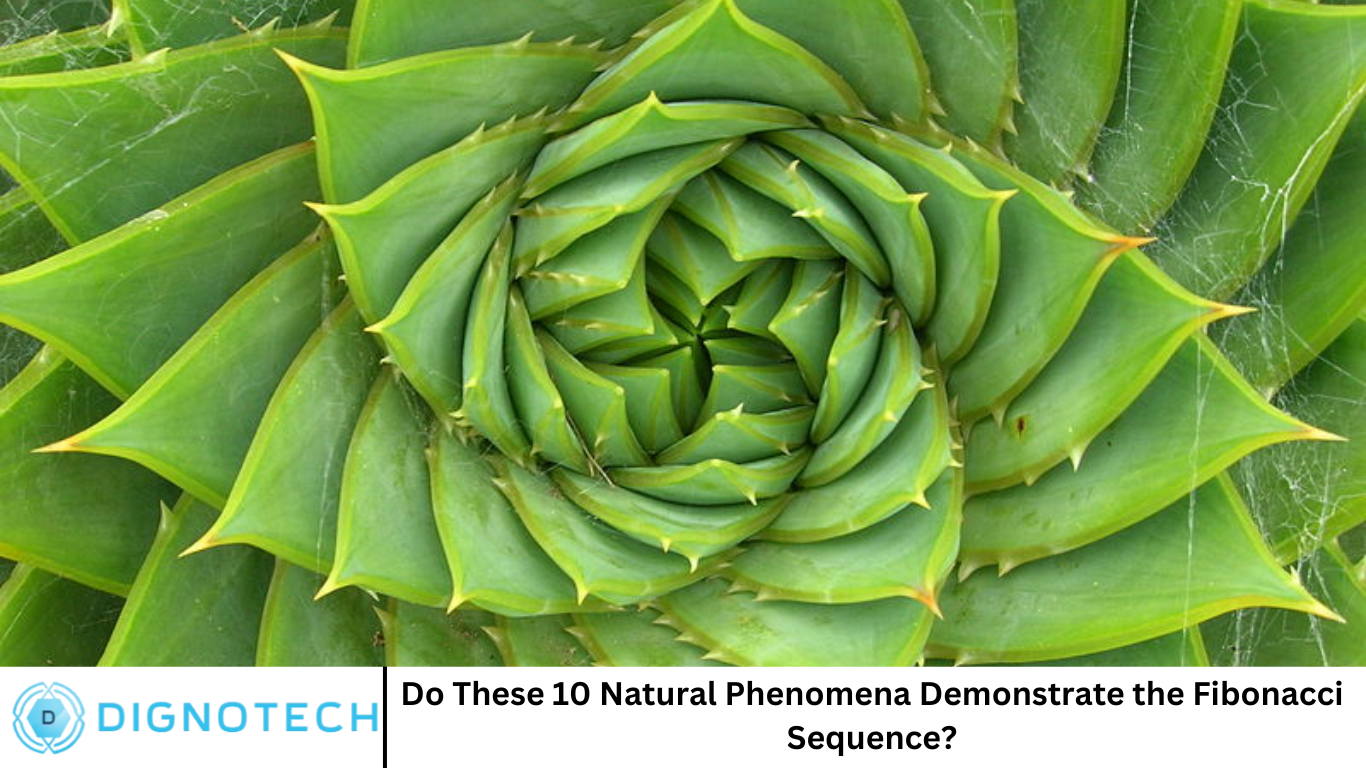Do These 10 Natural Phenomena Demonstrate the Fibonacci Sequence?

Hi everyone! How are you all doing? Welcome to dignotech.com! The Fibonacci sequence, a series of numbers where each number is the sum of the two preceding ones (starting from 0 and 1), has fascinated mathematicians, scientists, and artists for centuries. The sequence is commonly represented as: 0, 1, 1, 2, 3, 5, 8, 13, 21, and so on. As the sequence grows, the ratio between consecutive numbers approaches the golden ratio (approximately 1.618), a mathematical constant that appears in various natural, architectural, and artistic patterns.
But is the Fibonacci sequence truly present in the natural world, as so often claimed? Many claim that numerous natural phenomena—from the arrangement of leaves to the growth of shells—show a clear connection to the Fibonacci sequence. But does the evidence hold up? In this article, we will explore ten natural phenomena that are commonly associated with the Fibonacci sequence and analyze whether these patterns genuinely demonstrate the sequence in nature.
The Arrangement of Leaves (Phyllotaxis)
One of the most famous examples of the Fibonacci sequence in nature is the arrangement of leaves around a stem, known as phyllotaxis. Many plants and trees show a spiral arrangement of leaves that appears to follow the Fibonacci sequence. In these plants, each leaf is positioned at a specific angle relative to the previous one, which allows them to capture more sunlight and improve photosynthesis.
Plants such as sunflowers, pine cones, and pine trees often demonstrate this phenomenon. Typically, if you count the spirals of leaves on these plants, the numbers correspond to Fibonacci numbers (1, 2, 3, 5, 8, etc.). The reason behind this pattern is thought to be a result of optimal packing. By arranging leaves in a spiral, plants maximize their exposure to sunlight and ensure that each leaf has enough space for growth without blocking the leaves above or below it.
The Growth of Branches (Tree Branching)
The growth pattern of tree branches is another example where the Fibonacci sequence is often cited. As trees grow, their branches tend to follow a branching pattern that corresponds to the Fibonacci sequence. When a tree grows new branches, they often emerge at angles that are consistent with Fibonacci numbers. For instance, after a branch grows, subsequent branches will usually emerge at angles that fit the Fibonacci sequence, creating an efficient and organized structure for the tree’s growth.
Some biologists believe that this Fibonacci arrangement minimizes the amount of energy required for the tree to grow while maximizing sunlight exposure and space for each branch. Trees like the apple tree, pear tree, and many other species exhibit this pattern to some degree.
The Fibonacci Sequence in Flowers
Another striking example of the Fibonacci sequence in nature can be found in the petals of flowers. Many flowers have petals that correspond to Fibonacci numbers, such as 3, 5, 8, 13, and so on. The most famous example is the lily, which typically has 3 petals, or the sunflower, whose number of spirals can often be seen to match Fibonacci numbers.
Why does this happen? One possible explanation is that the Fibonacci arrangement allows flowers to maximize the packing of seeds or petals in an efficient way, ensuring that each part of the flower has optimal room to grow. This concept is part of what is known as “optimal packing” in nature—where nature uses the Fibonacci sequence to create patterns that maximize space and energy efficiency.
The Spiral Shape of Shells
The spiral shape of shells, such as the nautilus shell, is often cited as another example of the Fibonacci sequence in nature. Nautilus shells, as well as the shells of other mollusks, grow in a logarithmic spiral shape. The growth pattern follows the golden spiral, which is closely related to the Fibonacci sequence.
As the nautilus grows, the shell expands, but the shape remains a logarithmic spiral, meaning the width of each subsequent spiral increases by a constant factor. This growth pattern is related to the Fibonacci sequence because the number of spirals in the shell correlates to Fibonacci numbers. The logarithmic spiral allows the animal to grow in size without changing its shape drastically, helping the creature maintain balance and function.
The Spiral of Galaxies
The spiral shape of galaxies is another example that is often linked to the Fibonacci sequence. Many galaxies, including our Milky Way, exhibit a spiral structure. These galaxies are not perfectly Fibonacci spirals, but they do often display a similar spiral form that follows the same general principles of growth. The arms of the galaxy spread out in a manner that closely resembles the spiral curve, often related to the golden spiral.
The reason for the spiral structure of galaxies is rooted in the laws of physics and gravitation. Over time, the gravitational forces within a galaxy cause its stars and other components to spiral toward the center. While the exact relationship between Fibonacci numbers and these spirals remains debated, the resemblance to the Fibonacci sequence is apparent.
The Reproductive Patterns of Rabbits
One of the earliest recorded applications of the Fibonacci sequence comes from the famous Fibonacci sequence problem posed by Leonardo of Pisa (also known as Fibonacci) in his book Liber Abaci (1202). The problem is as follows: if a pair of rabbits is placed in an enclosed space and they reproduce according to a specific pattern (each pair produces another pair every month), how many pairs of rabbits will there be after a certain number of months?
This problem leads to the Fibonacci sequence, where the number of rabbit pairs follows the sequence 1, 1, 2, 3, 5, 8, 13, and so on. While this is a simplified model of rabbit reproduction, it effectively demonstrates the Fibonacci sequence. In real life, rabbit populations can grow in ways that are somewhat similar, though other factors like predation, disease, and food supply play a role in controlling populations.
The Arrangement of Seeds in a Sunflower
The arrangement of seeds in the head of a sunflower is another striking example of the Fibonacci sequence. The seeds are arranged in a spiral pattern, and if you count the number of spirals going outward, they often correspond to Fibonacci numbers. Sunflowers usually have two types of spirals—one running clockwise and the other counterclockwise—intersecting at precise angles.
This pattern allows the sunflower to pack seeds in the most efficient way, maximizing the number of seeds it can hold within the given space. The Fibonacci sequence helps ensure that the seeds are packed optimally, creating a beautiful and functional pattern.
The Growth of Fruit and Vegetables
Many fruits and vegetables also demonstrate Fibonacci-like growth patterns. For example, the arrangement of fruit on a tree often follows Fibonacci principles. A particularly well-known example is the growth pattern of the pineapple. Pineapples have diagonal spiral patterns on their skin that correspond to Fibonacci numbers.
Similarly, the growth of fruits like apples, tomatoes, and cucumbers often follows the principles of the Fibonacci sequence. In these cases, the spiral patterns or the way seeds are arranged within the fruit are closely aligned with Fibonacci numbers.
The Anatomy of Animals
The Fibonacci sequence also appears in the anatomy of various animals. One of the most well-known examples is the spiraling horns of certain animals, like the ram or the antelope. The number of spirals in the horns can sometimes correspond to Fibonacci numbers.
In addition, the pattern of growth in certain animals follows the Fibonacci sequence. For instance, the growth of certain species of starfish involves a pentagonal symmetry, which can be related to the Fibonacci sequence (since 5 is a Fibonacci number). Similarly, the number of segments in the bodies of many animals, including some marine creatures, may correspond to Fibonacci numbers.
Human Anatomy
While the Fibonacci sequence is most commonly associated with plants and animals, it also appears in human anatomy. Some researchers claim that various measurements in the human body follow Fibonacci numbers, such as the ratio between the length of the forearm and hand, or the width of a person’s face. However, these occurrences are often less strict than those found in other areas of nature.
One of the most famous examples in human anatomy is the “golden ratio” or “Phi,” which is closely linked to the Fibonacci sequence. In art, design, and architecture, the golden ratio is often used to create aesthetically pleasing proportions, and some suggest that it is present in human facial features, though this is more of a theory than a proven fact.
Frequently Asked Question
What is the Fibonacci sequence, and why is it important in nature?
The Fibonacci sequence is a series of numbers where each number is the sum of the two preceding ones, starting with 0 and 1. This sequence is important in nature because it appears in various natural patterns, such as the arrangement of leaves, flowers, and shells. The sequence helps organisms optimize their growth patterns for maximum efficiency and minimal energy expenditure.
Are all natural spirals related to the Fibonacci sequence?
Not all natural spirals are strictly related to the Fibonacci sequence. While many spiral structures, such as the shells of mollusks and the arms of galaxies, appear to follow the golden spiral closely related to Fibonacci numbers, these patterns are often approximations rather than exact representations.
How do Fibonacci numbers help plants grow?
Fibonacci numbers help plants grow in ways that maximize sunlight exposure and space efficiency. By following a spiral arrangement for leaves, branches, and flowers, plants can ensure optimal use of available resources and increase their chances of survival and reproduction.
Can humans find Fibonacci patterns in the body?
Some researchers claim that Fibonacci patterns are found in the proportions of the human body, such as the ratio of different body parts. However, these findings are often subjective and less consistent than those seen in plants and animals.
Are Fibonacci patterns purely aesthetic?
While Fibonacci patterns are often aesthetically pleasing, they are also functional. For example, the spiral patterns in sunflower seeds or the branching of trees allow for efficient packing and growth, benefiting the organisms that exhibit these patterns.
Why does the Fibonacci sequence appear in animal anatomy?
The Fibonacci sequence appears in animal anatomy, such as in the spiraling horns of rams or the segmentations of certain animals, because it allows for efficient and symmetrical growth. The golden ratio, related to Fibonacci numbers, is also associated with aesthetic balance, which may play a role in natural selection.
Does the Fibonacci sequence apply to all plants and animals?
No, not all plants and animals follow Fibonacci patterns. While the sequence is prevalent in many natural phenomena, there are numerous examples in nature where Fibonacci numbers do not appear. It’s important to recognize that the Fibonacci sequence is one of many mathematical patterns found in the natural world.
Conclusion
The Fibonacci sequence, with its intriguing properties and presence in nature, continues to captivate scientists, mathematicians, and artists alike. While not every natural phenomenon strictly adheres to the Fibonacci sequence, there is no denying that many plants, animals, and natural structures exhibit patterns that resemble Fibonacci numbers. From the spiral arrangement of seeds in sunflowers to the branching structure of trees, the Fibonacci sequence appears to play a fundamental role in organizing and optimizing growth in nature.




